20 Years After the Sumatra Earthquake: Indonesia and Tohoku Share Disaster Memories and Lessons for Future Generations
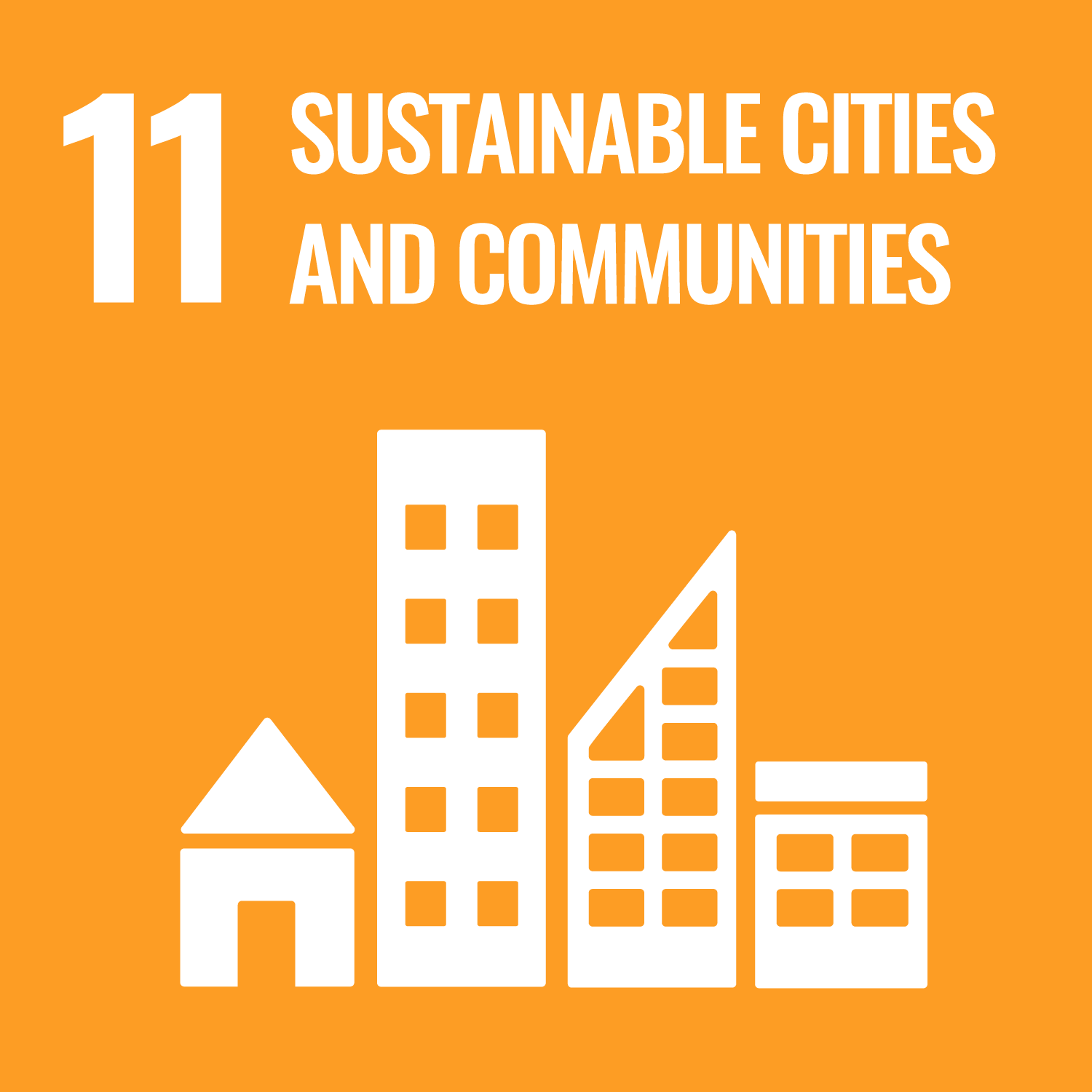
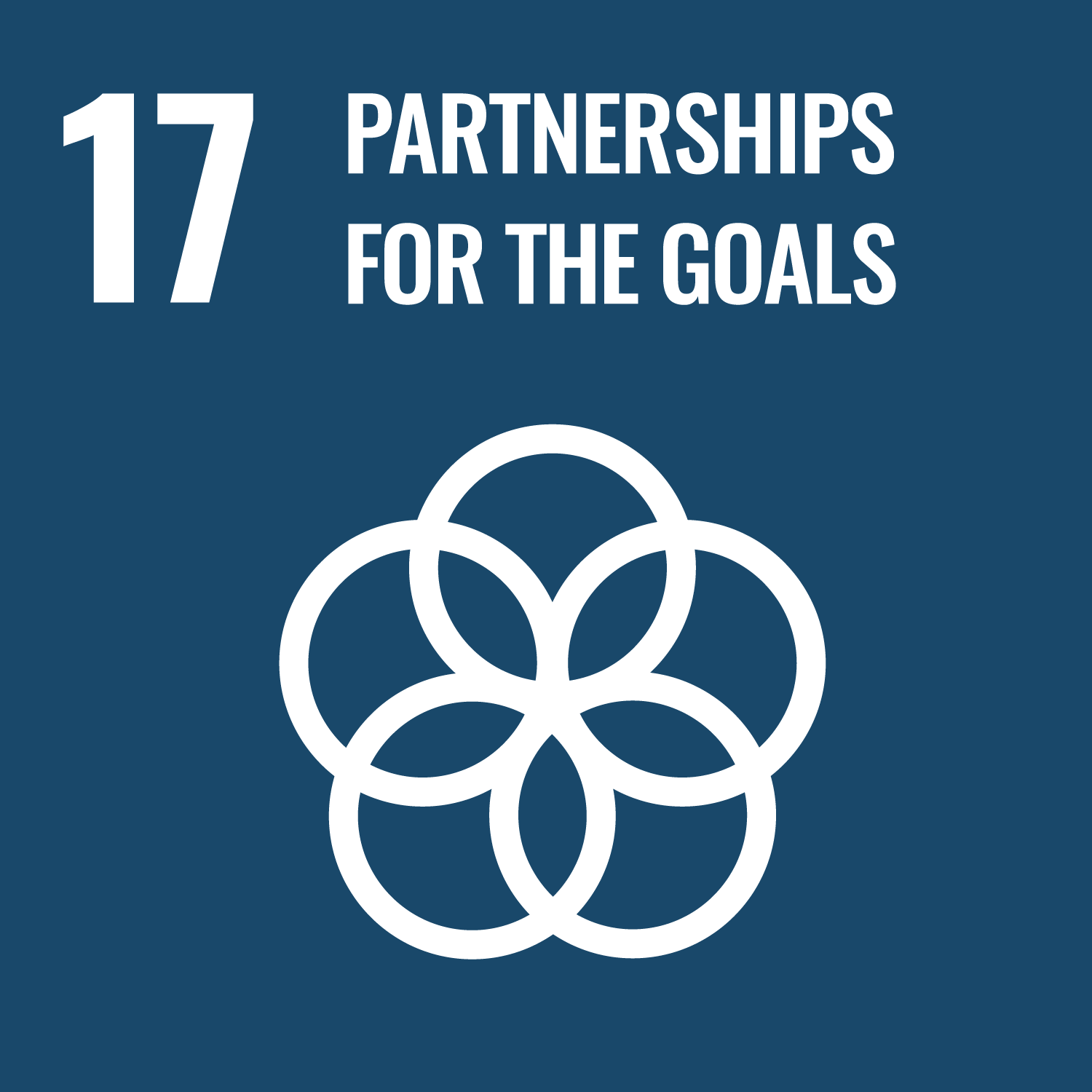
2024.12.10
The year 2024 marks the 20th anniversary of the devastating Sumatra earthquake and resultant Indian Ocean tsunami, which caused unprecedented damage to the coastlines of countries around the Indian Ocean. The damage was particularly severe in Indonesia. JICA not only provided emergency assistance immediately after the disaster, but has continued to support long-term recovery and reconstruction efforts. JICA has also fostered mutual learning through collaboration with municipalities in Indonesia and those in Japan’s Tohoku region that were impacted by the Great East Japan Earthquake.
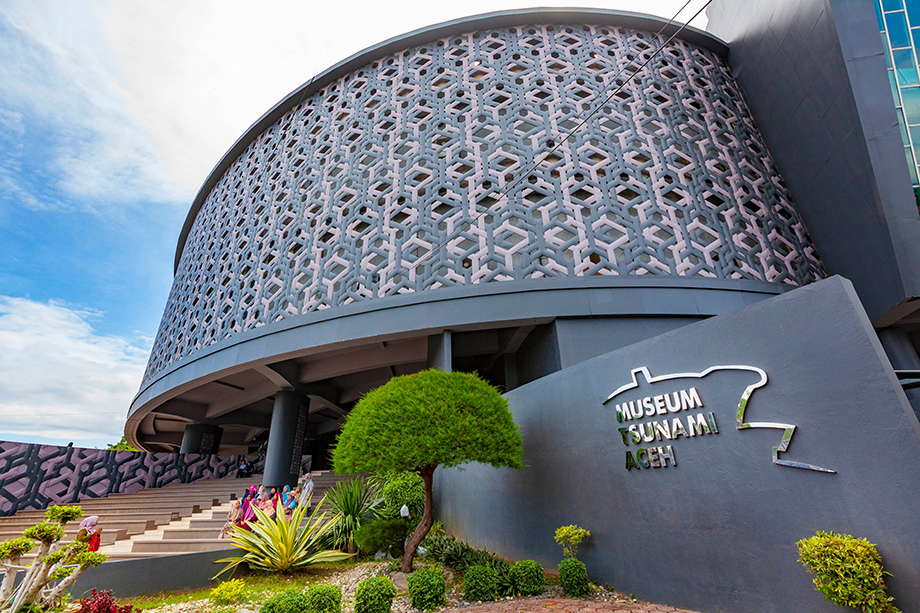
The Aceh Tsunami Museum in Banda Aceh, Aceh Province of Indonesia. The Museum was opened in 2009 to share memories and lessons from the Sumatra earthquake and tsunami disaster.
EDDY H/ Shutterstock.com
On December 26, 2004, a massive 9.0 magnitude earthquake struck off the coast of Sumatra, Indonesia, triggering a powerful tsunami that reached heights of up to 34 meters. The tsunami devastated countries around the Indian Ocean, leaving around 300,000 people dead or missing.
In response, Japan immediately deployed its largest-ever Disaster Relief Team to the hardest-hit regions, including Indonesia, Thailand, Sri Lanka, and the Maldives. Approximately 1,100 Japan Disaster Relief Team members were dispatched to Indonesia, where over 160,000 people dead or missing. The team provided medical care, transported supplies, and conducted search-and-rescue operations to locate survivors.
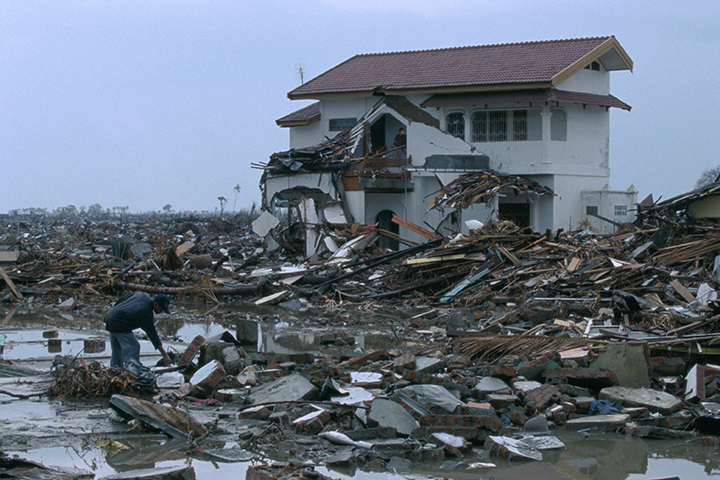
A residential area along the coast that was destroyed by the earthquake and tsunami.
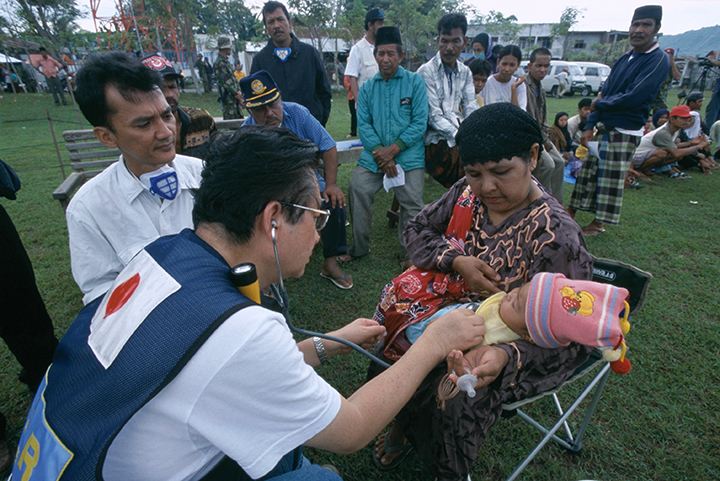
A doctor from the Japan Disaster Relief Team treated patients in the field.
Both photographs taken by Imamura Kenshiro, January 1, 2005
Damage was particularly severe in Banda Aceh, on the northern tip of Sumatra, Indonesia. The tsunami reached as far as 5 kilometers inland, killing over 70,000 people—around 30 percent of the area’s population. Following the immediate emergency relief efforts, JICA has continued its support for both structural and non-structural recovery and reconstruction efforts, including helping formulate a Basic Recovery and Reconstruction Plan for Banda Aceh, developing infrastructure, and supporting communities in becoming self-reliant.
This ongoing cooperation has led to a strong relationship between Banda Aceh and municipalities affected by the Great East Japan Earthquake of 2011. To this day, Banda Aceh and municipalities in Japan’s Tohoku region continue to collaborate, sharing knowledge on disaster risk reduction, community rebuilding, and passing down disaster preparedness lessons to future generations.
Muzailin Affan, head of the Office of International Affairs at Syiah Kuala University, was a survivor of the 2004 disaster, and has since worked closely with JICA on reconstruction efforts in the region.
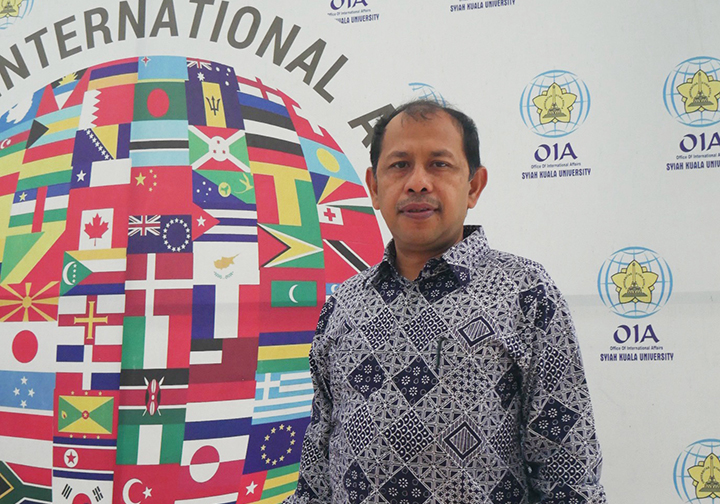
Muzailin Affan is head of the Office of International Affairs (OIA) at Syiah Kuala University.
According to Muzailin, Banda Aceh had experienced tsunamis in the past, but the knowledge and memories of those events were not passed down over generations. As a result, when the 2004 Sumatra earthquake and tsunami struck, it caught many by surprise and resulted in many casualties. “It was the strongest tremor that we’ve ever experienced,” he says. “But none of us at Banda Aceh, including myself, expected that a tsunami was coming.” Muzailin lost his own parents, four siblings, and many other relatives in the tsunami.
Despite the personal loss, when Muzailin heard that the Japan Disaster Relief Team was looking for people to help map the affected areas for post-disaster support for victims, he volunteered, hoping to apply his expertise in geographic information systems. This led to his involvement in the formulation of the Basic Recovery and Reconstruction Plan for Banda Aceh—and in a project aimed at supporting local residents’ self-reliance. Muzailin worked closely with JICA on the region’s reconstruction efforts. “Even after official aid ended, I could still see JICA working closely with disaster victims to help them live independently,” he says.
As Muzailin worked on recovery efforts, he began to consider how future disasters could be mitigated and what kind of response would be necessary. In 2010, he decided to deepen his understanding of disaster mitigation by pursuing doctoral research in 2010 at Tohoku University in the field of applied disaster management technology. Three months into his research, the Great East Japan Earthquake occurred. Coincidentally, Muzailin had been studying the use of breakwaters to reduce tsunami risks in the cities of Kamaishi and Rikuzentakata—two of the areas most severely damaged by the Great East Japan Earthquake. This made the disaster all the more relevant to him.
In response to the disaster in Tohoku, Muzailin sent a message of solidarity along with a donation from Banda Aceh, declaring, “Now it’s time for Banda Aceh to support Tohoku.” He also supported an initiative with JICA Tohoku that involved sending school teachers from Tohoku, including Miyagi and Iwate prefectures, to Banda Aceh. There, the teachers learned from Banda Aceh’s experiences with tsunami disaster recovery, and helped promote disaster risk reduction education. These efforts continue today.
Muzailin emphasizes that disaster risk management programs must involve a multi-sector, multi-stakeholder approach. He continues to advocate for educating young people—who will lead future generations—about the importance of disaster awareness and preparedness. “It is crucial to involve the younger generation, as education for sustainable development is essential,” he says.
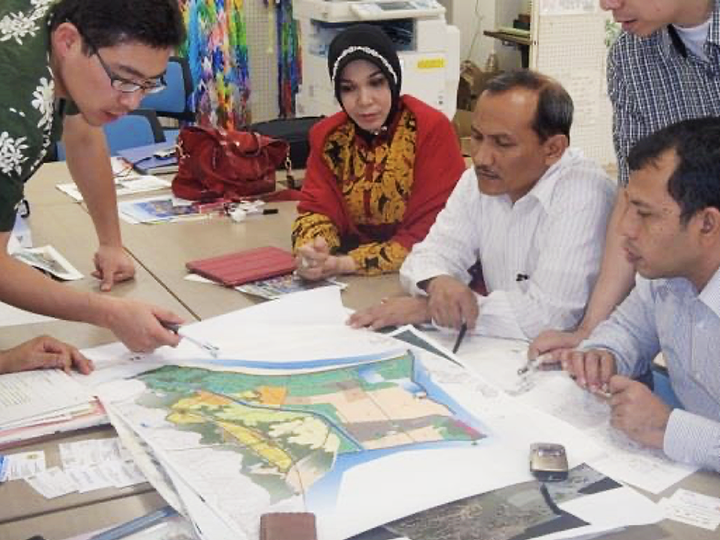
Representatives of Higashimatsushima City, JICA, and Deputy Mayor Illiza of Banda Aceh held a discussion on the reconstruction of the Tohoku region on August 9, 2012.
The collaboration between Banda Aceh and Tohoku began in May 2011, shortly after the Great East Japan Earthquake, when a former head of the Aceh Nias Rehabilitation and Reconstruction Agency visited the affected area. The partnership has continued in various forms, including training for Banda Aceh city officials by Higashimatsushima City in Miyagi Prefecture. As we mark the 20th anniversary of the Sumatra earthquake, the focus has shifted to passing on the lessons learned to future generations. One such initiative is the JICA Partnership Program, which involves a collaboration between the cities of Banda Aceh and Kamaishi City, where local residents are taking the lead in implementing disaster risk reduction programs.
Kamaishi City, severely damaged by the tsunami following the Great East Japan Earthquake, is known for the “Kamaishi incident,” in which most of the city’s children were safely evacuated—a result of the city’s strong tsunami disaster risk reduction education programs.
In May 2024, a group of 17 junior high school teachers from Banda Aceh, along with staff from the Aceh Tsunami Museum, visited Kamaishi, Otsuchi, Higashimatsushima and other affected areas to learn about disaster preparedness. At Kamaishi, one of the city’s municipal staff members involved in recovery and reconstruction efforts had been a junior high school student at the time, and shared their personal experience of evacuating during the disaster. The group also attended a mock evacuation drill. Some participants remarked that they had learned invaluable lessons, with one saying, “We learned the importance of disaster risk reduction education in schools.” Another added, "We want the children of Banda Aceh to experience this too.”
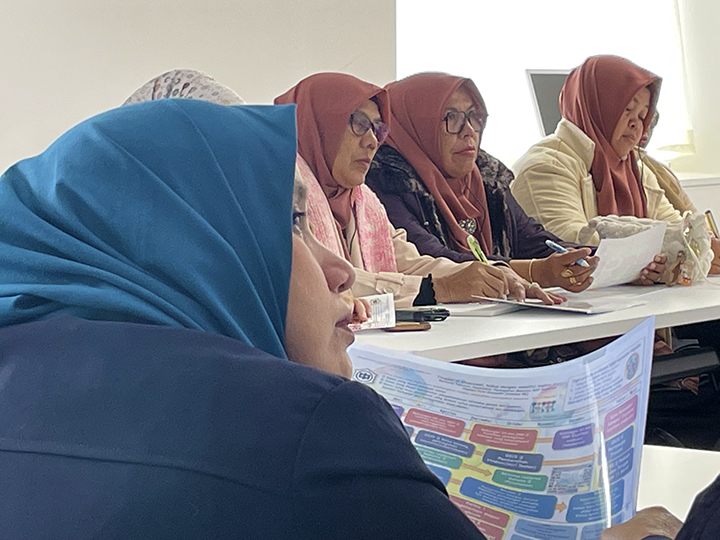
Participants from Banda Aceh learned about the Kamaishi Higashi Junior High School disaster risk reduction curriculum and how classes are conducted.
Participants experienced the speed of a tsunami by having a van drive past at 36 km/h, the average speed at which a tsunami travels.
Hosoe Eri is a project manager at Nebama MIND, which is implementing the project in cooperation with Kamaishi City. She explained the approach to promoting of disaster risk reduction in Banda Aceh: “We aim to give the teachers and students in Banda Aceh ample time to reflect on the issue and make it their own. We value sharing knowledge rather than having Japanese knowledge forced on them.” Participants from Banda Aceh expressed their enthusiasm, stating, “We want to be the best in the world at disaster risk reduction.”
In December 2023, members of the Reconstruction Study Group from Otsuchi High School in Iwate Prefecture visited Banda Aceh to share their experiences and lessons learned from the Great East Japan Earthquake with local junior and senior high school students. The Otsuchi High School students reflected on the importance of sharing personal experiences, with one commenting, “For people who have not experienced a disaster, simply conveying the damage through statistics, such as the destruction of buildings, is just numbers. It does not lead to an understanding of disaster preparedness. It is crucial to pass down firsthand experiences of what actually happened and the emotions that were felt.” Another student added, “I believe that by sharing my experiences, I can help ensure that they are passed down for the next 100 years.” Evidenced in these heartfelt remarks, the younger generation are key to preserving and transmitting the valuable lessons learned from past disasters.
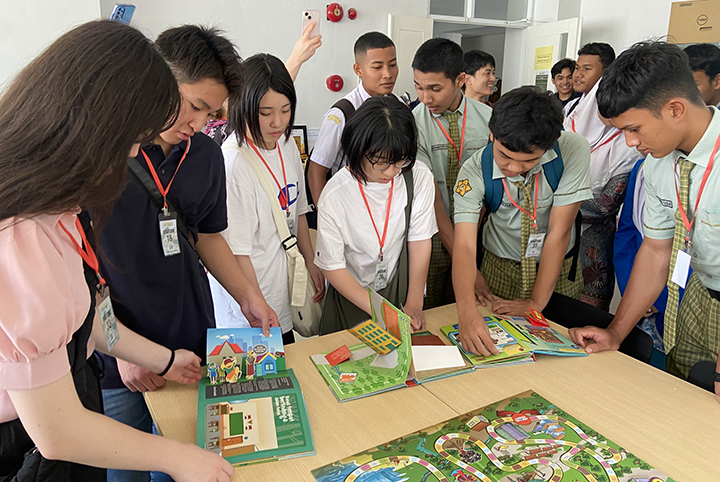
High school students from Banda Aceh and Otsuchi High School in Iwate Prefecture studied a disaster risk reduction education picture book created by a group of the Syiah Kuala University students.
scroll